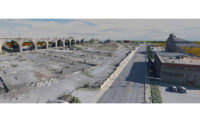Donald T. Resio, senior technologist in the Coastal and Hydraulics Laboratory at the U.S. Army Corps of Engineers Engineering Research and Development Center in Vicksburg, Miss., had an “ah-ha!” moment when he was trying to figure out how to plug a roaring levee breach: Use a big fabric tube floating in the flood, partially filled with water. Demonstrated at quarter-scale last fall on an 8-ft wide breach in a real levee at an agricultural research station in Stillwater, Okla., the device rolled into place riding the water pouring through the gap. It sealed the hole in 12 seconds flat, to the cheers of a crowd of scientists, levee board officials and engineers.

The principal is as simple as dirt, or simpler, really. A tube of non-stretch fabric, longer than the breach and of a diameter larger than the water depth at the gap, is dropped into the flood and 80% filled with water. Positioned upstream, the current pulls it toward the breach. The bubble of air inside keeps the top above the water as the tube drifts into place, guided by lines from either the levee or an offshore barge. As the tube runs aground near the breach, the roll slows and the tube snuggles into the gap. The current tries to bend it and force it through the hole, but the laws of physics get in the way. The incompressible nature of water and the unyielding fabric of the tube turns it into a rigid plug that conforms to the breach and seals it in a flash.
Resio says the principles are scalable, and the only thing needed to plug a larger breach, like the typical 40- to 60-footers in a Mississippi River flood, is a scaled-up fabric sack.
Engineers can do more than “just wait for the flood to stop,” Resio says. His six-person team set out to solve the “intractable problem” by inventing a new set of rapid levee repair techniques. “Its just fun stuff,” he says. “You put your mind to it and start flipping things around in your head.”

With visions of choppers bombing breached levees in New Orleans with sandbags for days, the challenge was to find a better way.
The project was commissioned by the federal Dept. of Homeland Security, which worries about failures of dams and levees. “They threw down the gauntlet, saying, ‘What can you do that would be a good proof-of-concept and would be big enough that people would take notice?’” Resio says. He was already working on a design for a fabric breakwater, and “I knew I could do it somehow with fabric, and one day the light bulb went on.”
He says a product based on the model tested in Stillwater should work for a breach up to 16 ft wide by 6 ft deep. DHS is considering commercializing that, but Resio cautions users will have to be trained and know the limitations. “The last thing I want to read is “Wonder-Weenie Takes Out a House,’” he laughs.
“We still need larger tests,” he adds. “If we can stop a 20 x 10-ft breach and show the tube works as well as for the 8 x 4-ft breach, we will be in really good shape.”






